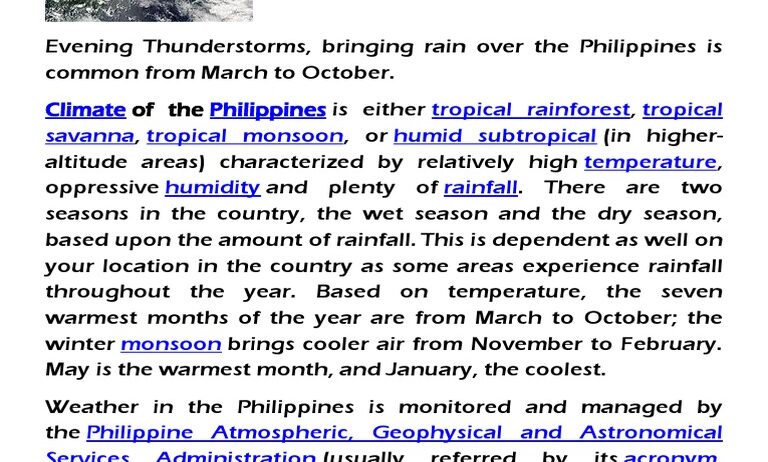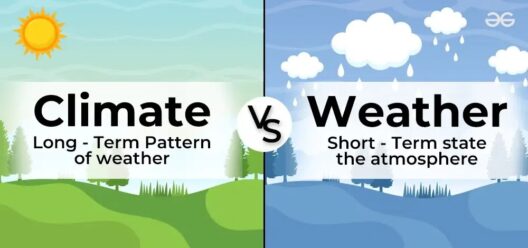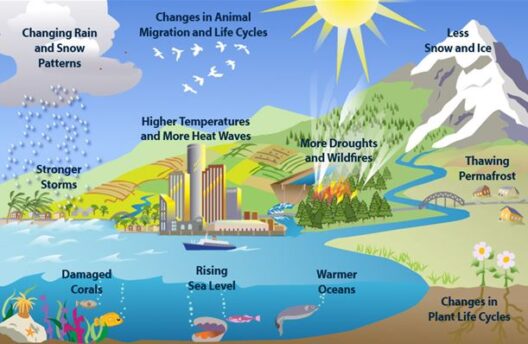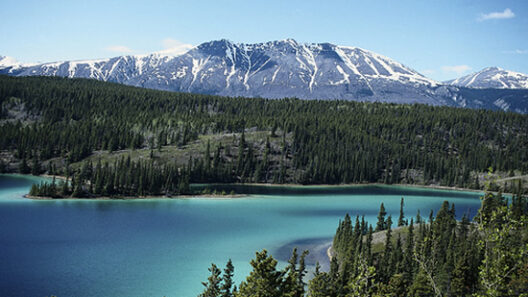The climate of the Philippines is a fascinating topic, largely shaped by its geographical features and unique climatic zones. As an archipelago of over 7,000 islands located in Southeast Asia, the country experiences a tropical maritime climate marked by pronounced wet and dry seasons. This raises an intriguing question: How do these climatic conditions impact not only the environment but also the daily lives of its inhabitants? Let’s delve into this complex interplay.
Situated close to the equator, the Philippines enjoys generally warm temperatures throughout the year. Average temperatures hover around 25°C to 32°C (77°F to 89.6°F). The unique geography of the islands, characterized by mountainous terrains, coastal regions, and extensive bodies of water, contributes significantly to localized climatic variations. For instance, islands such as Luzon, Visayas, and Mindanao exhibit diverse microclimates, affecting agricultural practices, biodiversity, and even local cultures.
One major characteristic of the climate is the dominance of the monsoon winds, which can be separated into two distinct seasons: the southwest monsoon (Habagat) and the northeast monsoon (Amihan). The southwest monsoon typically occurs from May to October, bringing intense rainfall and sometimes severe tropical storms. The torrential rains can cause flooding and landslides, posing significant risks to communities. Conversely, the northeast monsoon, from November to April, usually results in cooler, drier weather, which residents and farmers often find more favorable for outdoor activities.
The interaction between these monsoons creates a vivid seasonal tapestry, showcasing both the resilience and vulnerability of the Philippine people. For example, during the monsoon season, farmers engage in wet rice cultivation, which requires careful planning and understanding of the climate dynamics. The sporadic heavy rains can either bless them with bountiful harvests or lead to crop failure due to flooding. How then do farmers adapt their practices to mitigate these risks?
Climate variability is exacerbated by global climate change, resulting in increased frequency and intensity of extreme weather events. Typhoons, in particular, present a formidable challenge, with the Philippines experiencing an average of 20 typhoons annually. These storms carry devastating winds and rain, impacting infrastructure, displacing communities, and leading to loss of lives. The increase in sea surface temperatures, a direct effect of climate change, tends to intensify these storms. Coastal and island communities face additional vulnerabilities because of rising sea levels, resulting in erosion and loss of habitat.
The rich biodiversity of the Philippines is both a blessing and a challenge. The vast array of flora and fauna contributes to the ecological wealth of the islands, making them a global biodiversity hotspot. However, this biodiversity is threatened by climate-induced changes. The coral reefs, which provide essential ecosystem services and support local fisheries, are under siege from ocean acidification and rising sea temperatures. Moreover, shifts in climate patterns can disrupt migratory paths and breeding cycles of various animal species, raising questions about the long-term sustainability of these ecosystems.
On a brighter note, the lush greenery and diverse ecosystems owe much to the substantial rainfall during the monsoon season. Tropical rainforests, mangroves, and wetlands offer crucial habitat for wildlife while also acting as carbon sinks—potential allies in the fight against climate change. Conservation efforts are vital to preserve these ecosystems, but how can individuals and communities contribute to these initiatives? Grassroots movements and community engagements play a pivotal role in promoting environmental awareness and sustainable practices.
Tourism is another sector where the climate prominently impacts the economy. The Philippines attracts millions of tourists each year with its stunning beaches, vibrant culture, and unique biodiversity. However, climate change poses a challenge to this industry, as extreme weather events can deter visitors and lead to substantial economic losses. Additionally, coastal degradation threatens some of the most picturesque destinations. What strategies can be employed to ensure tourism remains resilient against climate-related changes?
In response to these climatic challenges, innovative solutions are emerging. The adoption of climate-smart agricultural practices is gaining momentum. Farmers are increasingly turning to varieties of crops that are resistant to floods or drought, practicing crop rotation, and utilizing integrated pest management techniques. Urban planners are also prioritizing sustainable infrastructure to alleviate flood risks and enhance the resilience of cities against typhoon impacts.
With all these dynamics at play, it becomes clear that understanding the climate of the Philippines is not merely an academic exercise but rather a necessity for the survival and prosperity of its people. As the nation grapples with the effects of climate change, fostering awareness and proactive strategies can counter some of the adverse impacts. Both citizens and policymakers must collaborate toward building more resilient communities.
In conclusion, the interplay between climate and the lives of people in the Philippines prompts critical reflection on our collective responsibilities. The lush tropical landscape, while bountiful and captivating, also harbors the potential for challenges that must be acknowledged and addressed. What role will you play in promoting sustainability and resilience in the face of these ongoing climatic changes? The answer could very well shape the future of the islands and their people.







